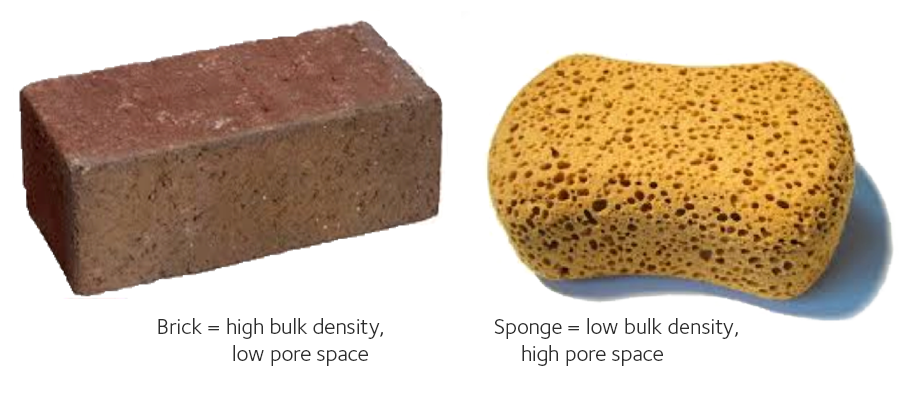In this fourth installment in the Everyday Soil Science series, we move our discussion to two important indicators of soil health that are often overlooked by gardeners and landscape professionals — bulk density and porosity.
The weighty subject of bulk density relates simply to the ratio of solids (i.e., sand, silt, and clay particles) to pore space (porosity) in a given sample of soil. Bulk density typically increases as the ratio of solids in a soil increases, and conversely decreases as the ratio of solids decreases. Looked at from the porosity perspective, bulk density increases as pore space decreases. The relationship of bulk density and porosity is reciprocal. As one increases, the other decreases.
Picture a brick. The brick is nearly 100% solid, so we’d say it has a “high” bulk density. Now picture a big sponge with lots of nooks and crannies of different sizes. The sponge is approximately 50% pore space, so we’d say it has a “low” bulk density. I could get mathematical on you at this point to quantify bulk density, but let’s keep it simple and focus on the relative difference. Brick = high bulk density. Sponge = low bulk density.
Generally speaking, loose, rich in organic matter, well aggregated and porous soils have a low bulk density. Sandy soils on the other hand have relatively high bulk since the sand particles can interlock to form a more solid mass with little pore space. This translates into sandy soils being easily compacted.
Bulk density then is an indicator of a common soil health problem that we’ve all encountered at some point – compaction. Compaction affects infiltration, rooting depth, water holding capacity, soil porosity, the availability of plant nutrients, and the activity of soil microbes.

Compacted soils have high bulk density.

Compacted soil with restricted root depth
Improving bulk density, alleviating compaction, and increasing soil porosity can be achieved through several easy-to-do management practices.
- Minimize soil disturbance by working the smallest area of soil possible with the least intrusive tool possible. Avoid rototilling, plowing and other forms of mechanical soil disturbance.
- When transplanting plants from large-sized containers, create lateral openings in the planting hole to facilitate air, water, and root movement.
- Never till or operate equipment when soils are wet.
- Utilize mulch, plant stubble, compost, and green manure (cover) crops to displace the weight of people and equipment on the soil surface.
- Always keep soil covered, even during short-term work activities.
- Use a diversity of plant materials (deep rooted as well as shallow rooted) to break up compacted soil layers.
- Aerate turf and planted areas twice annually using a tine-type aeration device.
- Apply a top-dressing of ¼” compost and/or compost tea every three months to all turf and planted areas to maintain active soil biology.
Implementing the practices above will go a long way to keeping the bulk density of your soil more like a sponge rather than a brick. And who plants in a brick…?
For more information about bulk density and soil porosity contact your local Master Gardener office, or click here to download an educational factsheet from the USDA, Natural Resources Conservation Service.
Remember, soil sustains life!
~The Soil Sommelier



